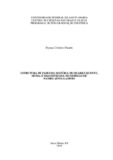| dc.creator | Duarte, Dyana Cristine | |
| dc.date.accessioned | 2018-12-27T09:47:27Z | |
| dc.date.available | 2018-12-27T09:47:27Z | |
| dc.date.issued | 2018-03-26 | |
| dc.identifier.uri | http://repositorio.ufsm.br/handle/1/15171 | |
| dc.description.abstract | In this thesis we make use of the NJL model to the study and description of the QCD phase
diagrams under different regimes of temperature, density and external magnetic fields. In our
first work we study the influence of the application of an external magnetic field in the diquark
condensation formation, and in the BEC-BCS crossover, in a system with two color degrees of
freedom. We have dedicated special attention to the regularization of divergent integrals, and to
the comparation with the smooth form factors scheme. We observe that the correct separation
of the magnetic contributions is crucial to the correct description of the system, without nonphysical
oscillations in the order parameters. In a second work we have studied a system with
chiral imbalance, and we have shown that a method that can extract all medium contributions
from divergent integrals before the regularization can explain why the well stablished chiral models
such as NJL fails in the description of the behavior of the critical temperature for the chiral
symmetry restoration with the increase of the chiral chemical potential m5, recently obtained by
lattice QCD simulations. Furthermore we present a way to cure the problem, using a method
that we call Medium Separation Scheme (MSS). Lastly, in our third work we came back to the
study of BEC-BCS crossover, in a more realistic model, with three colors and including the
color neutrality contidion, making use of an approximation that capture effects beyond mean
field, the Optimized Perturbation Theory (OPT). We saw that the using of OPT in the case with
neutrality require that the ratio between diquark and scalar coupling constants, Gd=Gs increase
considerably to the BEC phase exists, and consequently the BEC-BCS crossover, when comparing
with the Large Nc (or mean field) usual approximation. | eng |
| dc.description.sponsorship | Coordenação de Aperfeiçoamento de Pessoal de Nível Superior - CAPES | por |
| dc.language | por | por |
| dc.publisher | Universidade Federal de Santa Maria | por |
| dc.rights | Attribution-NonCommercial-NoDerivatives 4.0 International | * |
| dc.rights.uri | http://creativecommons.org/licenses/by-nc-nd/4.0/ | * |
| dc.subject | Diagrama de fases | por |
| dc.subject | Modelos efetivos | por |
| dc.subject | Regularização | por |
| dc.subject | Cromodinâmica quântica | por |
| dc.subject | Phase diagram | eng |
| dc.subject | Effective models | eng |
| dc.subject | Regularization | eng |
| dc.subject | Quantum chromodynamics | eng |
| dc.title | Estrutura de fases da matéria de quarks quente, densa e magnetizada no modelo de Nambu–Jona-Lasinio | por |
| dc.title.alternative | Phase structure of hot, dense and magnetized quark matter in Nambu–Jona-Lasinio model | eng |
| dc.type | Tese | por |
| dc.description.resumo | Nesta tese utilizamos o modelo de Nambu–Jona-Lasinio NJL para o estudo e descrição do diagrama
de fases da Cromodinâmica Quântica (QCD) em diferentes regimes de temperatura,
densidade e campos magnéticos externos. Em um primeiro trabalho estudamos a influência
da aplicação de um campo magnético externo na formação do condensado de diquarks e no
crossover BEC-BCS em um sistema com dois graus de liberdade de cor. Dedicamos atenção
especial à regularização das integrais divergentes e à comparação com o método dos fatores de
forma suaves. Vimos que a correta separação da contribuição magnética é crucial para a correta
descrição do sistema, sem que haja oscilações não-físicas nos parâmetros de ordem. Em um
segundo trabalho estudamos um sistema com desbalanceamento quiral, e mostramos que um
método que extrai todas as contribuições de meio das integrais divergentes antes de regularizálas
consegue explicar o porquê de modelos quirais tão bem estabelecidos como o NJL falharem
em descrever o comportamento da temperatura crítica de restauração da simetria quiral com
o aumento do potencial químico quiral m5, obtido recentemente por simulações de QCD na
rede. Além disso apresentamos uma maneira de sanar este problema, utilizando o método que
chamamos “Esquema de Separação dos Termos de Meio” (MSS). Por fim, no terceiro trabalho
retornamos ao estudo do crossover BEC-BCS utilizando um modelo mais realístico, com três
cores e incluindo a condição de neutralidade de cor, e com uma aproximação que captura efeitos
além de campo médio, a “Teoria de Perturbação Otimizada” (OPT). Vimos que a utilização
da OPT no caso com neutralidade faz com que a razão entre os acoplamentos de diquark e
escalar, Gd=Gs aumente consideravelmente para que exista a fase BEC, e consequentemente o
crossover BEC-BCS, em comparação com a aproximação de Large Nc (ou campo médio) usual. | por |
| dc.contributor.advisor1 | Farias, Ricardo Luciano Sonego | |
| dc.contributor.advisor1Lattes | http://lattes.cnpq.br/5045106337913025 | por |
| dc.contributor.referee1 | Riffel, Rogemar André | |
| dc.contributor.referee1Lattes | http://lattes.cnpq.br/7535636807201892 | por |
| dc.contributor.referee2 | Avancini, Sidney dos Santos | |
| dc.contributor.referee2Lattes | http://lattes.cnpq.br/8593700785501754 | por |
| dc.contributor.referee3 | Frederico, Tobias | |
| dc.contributor.referee3Lattes | http://lattes.cnpq.br/8102013525548196 | por |
| dc.contributor.referee4 | Timoteo, Varese Salvador | |
| dc.contributor.referee4Lattes | http://lattes.cnpq.br/7138726557754661 | por |
| dc.creator.Lattes | http://lattes.cnpq.br/4958262952068040 | por |
| dc.publisher.country | Brasil | por |
| dc.publisher.department | Física | por |
| dc.publisher.initials | UFSM | por |
| dc.publisher.program | Programa de Pós-Graduação em Física | por |
| dc.subject.cnpq | CNPQ::CIENCIAS EXATAS E DA TERRA::FISICA | por |
| dc.publisher.unidade | Centro de Ciências Naturais e Exatas | por |



